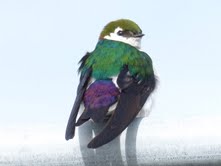
As one would expect of a birding cruise, our primary focus is on waterbirds, and the trip is, of course, full of Auklets and Guillemots and Murrelets and Oystercatchers and Gulls and Terns and Cormorants and Harlequin Ducks and others. This past saturday we also spotted a few Common Murres, just beginning to wander back into the Salish Sea from their breeding colonies along the outer coast – and also a rather early Heermann’s Gull. However, our (very beautiful and scenic) route meanders through islands and near shorelines, and consequently we do encounter quite a few land-based birds as well, and I thought they deserved a mention in the blog.
Raptors we’ve already discussed a bit – especially the Ospreys and the Bald Eagles. The Ospreys were observed again at one of the three nest sites we check – they put on a bit of a show for us, gathering sticks to enhance their nest by plucking them from the surface of the bay. And at one of the Eagle nests we were excited to see a scruffy juvenile Eagle at last, staring defiantly down at the boat as we floated below. Red-tailed Hawks are also fairly common, especially soaring as we putt through the Swinomish Channel, and we’ve seen the odd Northern Harrier or Cooper’s Hawk now and again. A Merlin or Peregrine Falcon would be a lucky encounter.
The Swinomish Channel is a very narrow stip of water separating Fidalgo Island from the mainland, and we tend to pass slowly through this interesting and picturesque area, leaving the alcids temporarily behind in favor of birds of field and forest. Of course, it helps to have good birding ears, because many species are detected by voice more than they are seen. White-crowned Sparrows and Song Sparrows are singing everywhere, as well as Savannah Sparrows in open country. Marsh Wrens, Common Yellowthroats, and Yellow Warblers sing here and there, while birds seen passing over the channel or flying nearby sometimes include Morning Dove, Eurasian Collared-Dove, Northern Flicker, Pileated Woodpecker, American Robin, Red-winged Blackbird, Brewer’s Blackbird, or Spotted Towhee. It’s nice to sit back and relax in the sun and just watch and listen as we travel. Many of the shoreline houses in the LaConner area have bird feeders, and we usually see a few House Finches, American Goldfinches, Oregon Juncos, or Pine Siskins. We’ve spotted both Rufous and Anna’s Hummingbirds as well, although the former is more frequent.
Swallows are a fascinating and sometimes under-appreciated group of birds – on some trips, five species of swallow can be identified, especially in the Swinomish Channel. Barn Swallows and Violet-green Swallows are very numerous. The Violet-green in particular is seen at many of the sites we visit, although to appreciate its colors properly, one must be lucky enough to see it perched in good sunlight and from the right angle. In flight they are best identified by the pattern of the white flank patches. The colonially-nesting Cliff Swallow is found under the rte. 20 bridge at the northern end of the channel, where the swirling mass of birds is noted as we pass below. The very non-colonial, mud-bank nesting Northern Rough-winged Swallow occurs in much smaller numbers, and Tree Swallows are occasionally seen. Purple Martins also nest very locally in small numbers at sites near our route, and should be kept in mind.
Orange-crowned Warblers have been singing loudly since April and are often heard, even from the scrubby growth on some of the smaller islets. But other neotropical migrants have been in full song for several weeks now too, and the voices of forest birds frequently drift out to the boat. The Olive-sided Flycatcher’s loud whistle carries well out over water, and sometimes we also hear its smaller cousin, the Pacific-slope Flycatcher. Bewick’s Wren, Pacific Wren, and the migrant House Wren have all sung for us. But the prettiest song of all is that of the Swainson’s Thrush, the “salmonberry bird” whose lovely tones are the most characteristic sound of the wet Pacific forest in June.
Bird List for June 29 Cruise. 49 Species.
Brandt’s Cormorant: 6
Pelagic Cormorant: 100+
Double-crested Cormorant: 85
Great-blue Heron: 100+
Canada Goose: 12
Mallard: 4
Harlequin Duck: 50+
Surf Scoter: 45
Black Oystercatcher:Â 18
Caspian Tern: 300+
Glaucous-winged Gull: Omnipresent
California Gull: 60
Ring-billed Gull: 3
Heerman’s Gull: 1
Marbled Murrelet: 9
Rhinocerous Auklet: 100’s
Pigeon Guillemot: 100’s
Turkey Vulture: 4
Bald Eagle: 11 (incl. 3 nests)
Osprey: 3 active nests
Northern Harrier: 1
Rock Pigeon: 25
Belted Kingfisher: 6
Rufous Hummingbird: 1
Olive-sided Flycatcher: 1
Barn Swallow: 75
Cliff Swallow: 40
N. Rough-winged Swallow: 2
Violet-green Swallow: 60
Northern Flicker: 2
Crow Spp.: 25
Red-breasted Nuthatch: 1
American Robin: 4
House Wren: 1
Orange-crowned Warbler: 3
Yellow Warbler: 1
Common Yellowthroat: 1
Red-winged Blackbird: 2
Brewer’s Blackbird: 1
Brown-headed Cowbird: 1
Black-headed Grosbeak: 1
Spotted Towhee: 1
White-crowned Sparrow: Many singing
Song Sparrow: Many singing
Savannah Sparrow: 3
House Finch: 6
American Goldfinch: 2
House Sparrow: 10
Starling: 300+




